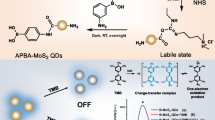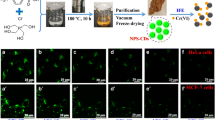Abstract
A method is described for the fluorometric determination of hypochlorite. It is making use of molybdenum disulfide quantum dots (MoS2 QDs) as a fluorescent probe. The QDs are prepared by hydrothermal reaction of sodium molybdate with glutathione. They possess diameters typically ranging from 1.4 to 3.8 nm, excellent stability in water, and blue photoluminescence (with excitation/emission peaks located at 315/412 nm and a quantum yield of 3.7%). The fluorescence of the QDs is statically quenched by hypochlorite, and the Stern-Volmer plot is linear. Hypochlorite can be detected in the 5–500 μM concentration range with a 0.5 μM detection limit. The method has been successfully applied to the determination of hypochlorite in spiked samples of tap water, lake water, and commercial disinfectants.

Schematic of a method for the fluorometric determination of hypochlorite using MoS2 quantum dots as a fluorescent probe. It has been applied to hypochlorite assay in spiked samples of tap water, lake water, and commercial disinfectants.





Similar content being viewed by others
References
Wang QH, Kalantar-Zadeh K, Kis A, Coleman JN, Strano MS (2012) Electronics and optoelectronics of two-dimensional transition metal dichalcogenides. Nat Nanotechnol 7:699–712
Chhowalla M, Shin HS, Eda G, Li L-J, Loh KP, Zhang H (2013) The chemistry of two-dimensional layered transition metal dichalcogenide nanosheets. Nat Chem 5:263–275
Splendiani A, Sun L, Zhang Y, Li T, Kim J, Chim C-Y, Galli G, Wang F (2010) Emerging photoluminescence in monolayer MoS2. Nano Lett 10:1271–1275
Xu S, Li D, Wu P (2015) One-pot, facile, and versatile synthesis of monolayer MoS2/WS2 quantum dots as bioimaging probes and efficient electrocatalysts for hydrogen evolution reaction. Adv Funct Mater 25:1127–1136
Lin H, Wang C, Wu J, Xu Z, Huang Y, Zhang C (2015) Colloidal synthesis of MoS2 quantum dots: size-dependent tunable photoluminescence and bioimaging. New J Chem 39:8492–8497
Liu Q, Hu C, Wang X (2016) A facile one-step method to produce MoS2 quantum dots as promising bio-imaging materials. RSC Adv 6:25605–25610
Ren X, Pang L, Zhang Y, Ren X, Fan H, Liu S (2015) One-step hydrothermal synthesis of monolayer MoS2 quantum dots for highly efficient electrocatalytic hydrogen evolution. J Mater Chem A 3:10693–10697
Wang Y, Ni Y (2014) Molybdenum disulfide quantum dots as a photoluminescence sensing platform for 2,4,6-trinitrophenol detection. Anal Chem 86:7463–7470
Haldar D, Dinda D, Saha SK (2016) High selectivity in water soluble MoS2 quantum dots for sensing nitro explosives. J Mater Chem C 4:6321–6326
Wang Z, Lin J, Gao J, Wang Q (2016) Two optically active molybdenum disulfide quantum dots as tetracycline sensors. Mater Chem Phys 178:82–87
Gu W, Yan Y, Zhang C, Ding C, Xian Y (2016) One-step synthesis of water-soluble MoS2 quantum dots via a hydrothermal method as a fluorescent probe for hyaluronidase detection. ACS Appl Mater Interfaces 8:11272–11279
Yu J, Ma X, Yin W, Gu Z (2016) Synthesis of PVP-functionalized ultra-small MoS2 nanoparticles with intrinsic peroxidase-like activity for H2O2 and glucose detection. RSC Adv 6:81174–81183
Dong H, Tang S, Hao Y, Yu H, Dai W, Zhao G, Cao Y, Lu H, Zhang X, Ju H (2016) Fluorescent MoS2 quantum dots: Ultrasonic preparation, up-conversion and down-conversion bioimaging, and photodynamic therapy. ACS Appl Mater Interfaces 8:3107–3114
Lin W, Long L, Chen B, Tan W (2009) A ratiometric fluorescent probe for hypochlorite based on a deoximation reaction. Chem Eur J 15:2305–2309
Yue Y, Huo F, Yin C, Escobedoc JO, Strongin RM (2016) Recent progress in chromogenic and fluorogenic chemosensors for hypochlorous acid. Analyst 141:1859–1873
Sugiyama S, Kugiyama K, Aikawa M, Nakamura S, Ogawa H, Libby P (2004) Hypochlorous acid, a macrophage product, induces endothelial apoptosis and tissue factor expression: involvement of myeloperoxidase-mediated oxidant in plaque erosion and thrombogenesis. Arterioscler Thromb Vasc Biol 24:1309–1314
Steinbeck MJ, Nesti LJ, Sharkey PF, Parvizi J (2007) Myeloperoxidase and chlorinated peptides in osteoarthritis: potential biomarkers of the disease. J Orthop Res 25:1128–1135
Benhar M, Engelberg D, Levitzki A (2002) ROS, stress-activated kinases and stress signaling in cancer. EMBO Rep 3:420–425
Yuan L, Lin W, Song J, Yang Y (2011) Development of an ICT-based ratiometric fluorescent hypochlorite probe suitable for living cell imaging. Chem Commun 47:12691–12693
Chen S, Lu J, Sun C, Ma H (2010) A highly specific ferrocene-based fluorescent probe for hypochlorous acid and its application to cell imaging. Analyst 135:577–582
Liu L, Zhang J, Su X, Mason RP (2008) In vitro and in vivo assessment of CdTe and CdHgTe toxicity and clearance. J Biomed Nanotechnol 4:524–528
Cayuela A, Soriano ML, Valcárcel M (2013) Strong luminescence of carbon dots induced by acetone passivation: Efficient sensor for a rapid analysis of two different pollutants. Anal Chim Acta 804:246–251
Wang Y, Zhang P, Ye C, Fu W, Yuan H, Hu P, Liu Y (2018) Hexamethylenetetramine: an effective and universal nitrogen-doping reagent to enhance the photoluminescence of carbon nanodots. New J Chem 42:3519–3525
Park S, Choi S, Yu J (2014) DNA-encapsulated silver nanodots as ratiometric luminescent probes for hypochlorite detection. Nanoscale Res Lett 9:129
Zhang P, Wang Y, Chen L, Yin Y (2017) Bimetallic nanoclusters with strong red fluorescence for sensitive detection of hypochlorite in tap water. Microchim Acta 184:3781–3787
Xia X, Zhang Y, Wang J (2014) Novel fabrication of highly fluorescent Pt nanoclusters and their applications in hypochlorite assay. RSC Adv 4:25365–25368
Tang Q, Yang T, Huang Y (2015) Copper nanocluster-based fluorescent probe for hypochlorite. Microchim Acta 182:2337–2343
Gu W, Yan Y, Cao X, Zhang C, Ding C, Xian Y (2016) A facile and one-step ethanol-thermal synthesis of MoS2 quantum dots for two-photon fluorescence imaging. J Mater Chem B 4:27–31
Galea NM, Kadantsev ES, Ziegler T (2009) Modeling hydrogen sulfide adsorption on Mo-edge MoS2 surfaces under solid oxide fuel cell conditions. J Phys Chem C 113:193–203
Vashist SK, Luppa PB, Yeo LY, Ozcan A, Luong JHT (2015) Emerging technologies for next-generation point-of-care testing. Trends Biotechnol 33:692–705
Acknowledgements
This work was supported by the National Natural Science Foundation of China (No. 21775014, 21505012, and 81501837), Chongqing Research Program of Basic Research and Frontier Technology (No. cstc2017jcyjAX0368), Program for Top-Notch Young Innovative Talents of Chongqing Normal University (No. 02030307-00026), and Chongqing Research Program on Teaching Reform of Higher Education (No. 153062). Y.W. (Yue Wang), Q.T. and W.L. are also supported by Chongqing Undergraduate Training Program for Innovation and Entrepreneurship (No. 201710637007).
Author information
Authors and Affiliations
Corresponding author
Ethics declarations
The author(s) declare that they have no competing interests.
Electronic supplementary material
ESM 1
(DOC 10244 kb)
Rights and permissions
About this article
Cite this article
Wang, Y., Zhang, P., Lu, Q. et al. Water-soluble MoS2 quantum dots are a viable fluorescent probe for hypochlorite. Microchim Acta 185, 233 (2018). https://doi.org/10.1007/s00604-018-2768-8
Received:
Accepted:
Published:
DOI: https://doi.org/10.1007/s00604-018-2768-8




